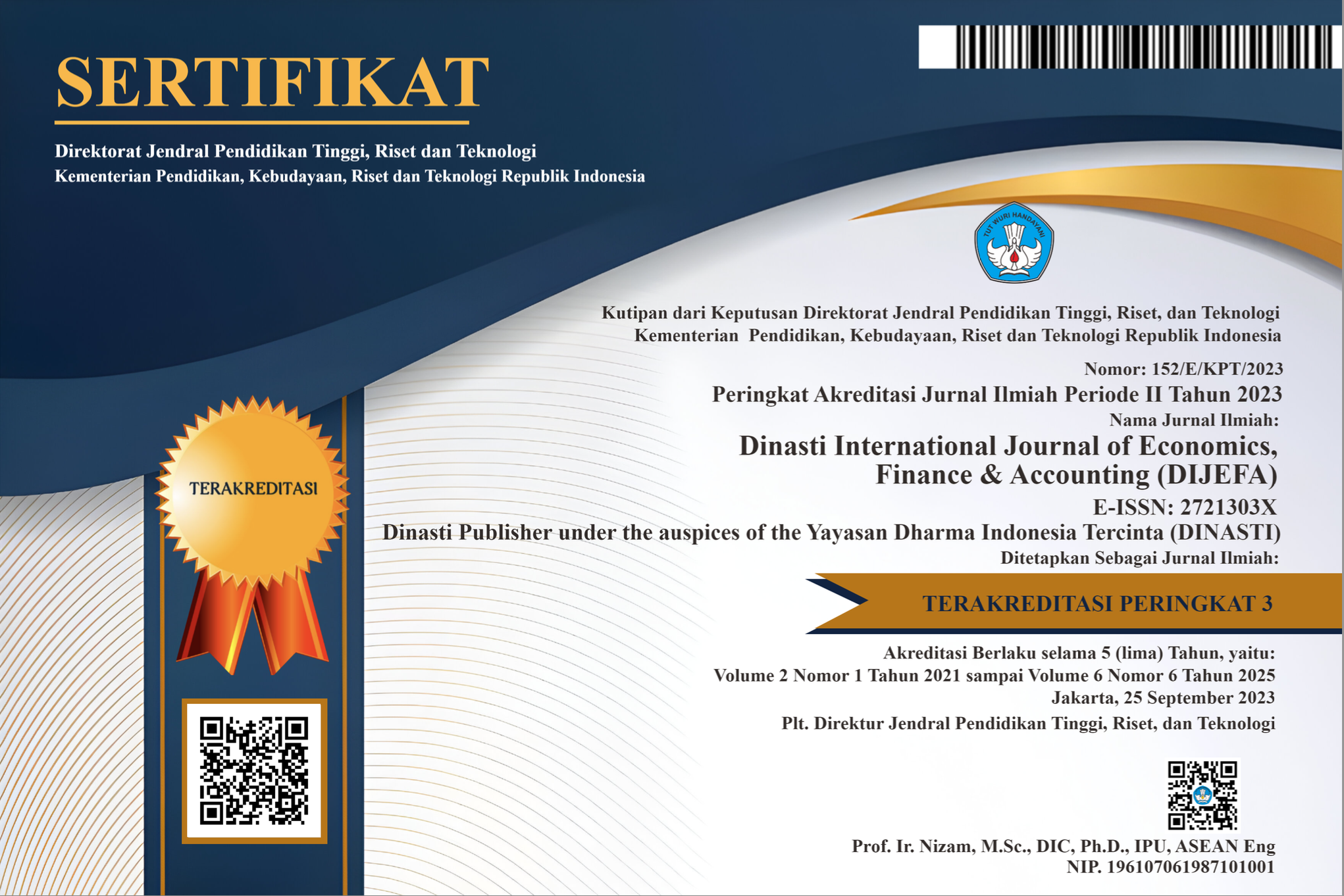Monetization of Tiktok Affiliate Marketing on Customer Engagement of Skin Care Products: A Halal Social Media Perspective
DOI:
https://doi.org/10.38035/dijefa.v5i3.2916Keywords:
Tiktok Affiliate Marketing, Customer Engagement, Halal Social MediaAbstract
Halal industry is not only in products such as food, drinks or products that can be consumed directly, but also in the use of social media. The content available on social media, in this case TikTok, is not only content in entertainment packaging but also marketing a product. Skin care products are no exception. There is content that has been created by affiliates on TikTok to attract consumers to make purchases. This study provides findings on how halal social media in moderating the relationship between tiktok affiliates and the number of consumers interested in skin care products. The implication is that, for business actors, investing in social media, especially to make their products in accordance with Islamic sharia, will provide benefits, especially so that Muslim consumers can choose or buy these products. As for the research conducted, it was found that In the model, the results of the analysis show findings that the determinants of consumer intention to purchase halal cosmetic products are significantly influenced through all variables, namely Tiktok Affiliate Marketing, Custoner Engagement, and Halal Social Media where all the hypotheses proposed are proven to fulfill the initial hypothesis proposed.
References
Ag Majid, D. K. Z., Abdul Hanan, S., & Hassan, H. (2021). A mediator of consumers’ willingness to pay for halal logistics. British Food Journal, 123(3), 910–925. https://doi.org/10.1108/BFJ-01-2020-0047
Bhutto, M. Y., Ertz, M., Soomro, Y. A., Khan, M. A. A., & Ali, W. (2022). Adoption of halal cosmetics: extending the theory of planned behavior with moderating role of halal literacy (evidence from Pakistan). Journal of Islamic Marketing, 14(6), 1488–1505. https://doi.org/10.1108/JIMA-09-2021-0295
Binsaeed, R. H., Yousaf, Z., Grigorescu, A., Chitescu, R. I., Nassani, A. A., & Samoila, A. (2023). Customer Engagement and Customer Relationship Management Capabilities’ Effects on Innovation Performance and Customer Distrust’s Moderating Role. Sustainability (Switzerland), 15(12). https://doi.org/10.3390/su15129475
Bozkurt, S., Gligor, D., & Gligor, N. (2022). Investigating the impact of psychological customer engagement on customer engagement behaviors: the moderating role of customer commitment. Journal of Marketing Analytics, 10(4), 408–424. https://doi.org/10.1057/s41270-021-00146-3
Chen, J., Zhang, Y., Cai, H., Liu, L., Liao, M., & Fang, J. (2024). A Comprehensive Overview of Micro-Influencer Marketing: Decoding the Current Landscape, Impacts, and Trends. Behavioral Sciences, 14(3). https://doi.org/10.3390/bs14030243
Choi, L., Kim, M. R., & Kwon, H. B. (2022). Impact of customer-based corporate reputation on customer engagement behaviors: customer identification and brand love as mediators and industry type as a moderator. Journal of Brand Management, 29(2), 150–166. https://doi.org/10.1057/s41262-021-00255-5
de Silva, T. M. (2021). The role of customer engagement in cultivating relationships with automotive Facebook brand pages. Online Information Review, 45(7), 1362–1380. https://doi.org/10.1108/OIR-11-2019-0352
Dhankhar, D., Gaur, V., Singh, L., & Kumar, P. (2023). The Impact of Digital Marketing Practices on Tourist Buying Behavior: A Study of Indian Tourism Industry. International Journal of Hospitality and Tourism Systems, 16(3), 110–121.
Feizollah, A., Mostafa, M. M., Sulaiman, A., Zakaria, Z., & Firdaus, A. (2021). Exploring halal tourism tweets on social media. Journal of Big Data, 8(1). https://doi.org/10.1186/s40537-021-00463-5
Fox, P. B., & Wareham, J. D. (2010). Governance mechanisms in internet-based affiliate marketing programs in Spain. International Journal of E-Business Research, 6(1), 1–18. https://doi.org/10.4018/jebr.2010100901
Herjanto, H., Amin, M., & Karmagatri, M. (2023). A systematic review on halal cosmetic consumption: application of theory method context –attributes decision outcome framework. Journal of Islamic Accounting and Business Research, 14(1), 58–79. https://doi.org/10.1108/JIABR-12-2021-0315
Issn, A., Chefe, I. E., Luiz, C., Avalia, S., & Review, D. B. (2023). AFFILIATED MARKETING CONTENT IN SHOPEE THROUGH TIKTOK MEDIA 1 INTRODUCTION Marketing tools play a crucial role in facilitating the sale of goods and services to consumers . The significance of this process has led to the development of various marketing strategies across different channels to optimize product sales ( Piranda et al ., 2022 ). Among these strategies , affiliate marketing has gained significant popularity in recent times . Affiliate marketing is a well-known tactic utilized by several e-commerce businesses in Indonesia , offering additional advantages to reseller business owners who compete to engage customers and create compelling content ( Kee & Yazdanifard , 2015 ). This marketing content aims to capture the attention of digital consumers and motivate them to make purchases ( Astari , 2017 ). Indonesia has experienced a substantial increase in internet users , with the number continuing to rise . In 2018 , the number of users grew by 54 . 25 % compared to the previous year , and there was a remarkable 73 . 7 % growth within that same period . As of January 2022 , Indonesia ’ s population reached 277 . 7 million , with over one third of the population having internet access . This surge in internet usage highlights the significant progress made in recent years across the country . It is expected that the government will continue to prioritize expanding internet access to all regions nationwide . In this digital age , the internet plays a vital role in providing the general public with access to educational , business , and recreational resources , making it an invaluable tool for various purposes . 1–12.
Javornik, A., & Mandelli, A. (2012). Behavioral perspectives of customer engagement: An exploratory study of customer engagement with three Swiss FMCG brands. Journal of Database Marketing and Customer Strategy Management, 19(4), 300–310. https://doi.org/10.1057/dbm.2012.29
Kim, J., & Kim, J. E. (2014). Making customer engagement fun: Customer-salesperson interaction in luxury fashion retailing. Journal of Fashion Marketing and Management, 18(2), 133–144. https://doi.org/10.1108/JFMM-04-2013-0050
Kosiba, J. P. B., Boateng, H., Okoe Amartey, A. F., Boakye, R. O., & Hinson, R. (2018). Examining customer engagement and brand loyalty in retail banking: The trustworthiness influence. International Journal of Retail and Distribution Management, 46(8), 764–779. https://doi.org/10.1108/IJRDM-08-2017-0163
Kumar Sunny, K. S. (2022). An Exploratory Study of Millennial Consumer Behavior Antecedents using Influencer Marketing. Journal of Science and Technology, 7(4), 99–121. https://doi.org/10.46243/jst.2022.v7.i04.pp99-121
Lee, Y.-F., Chen, C.-Y., Chou, Y.-L., & Lin, Y.-H. (2024). Green Consumer Behavior of Sports Enthusiasts on TikTok—An Analysis of the Moderating Effect of Green Concern. Behavioral Sciences, 14(4), 285. https://doi.org/10.3390/bs14040285
Osman, S., Cheng, K. W., & Wider, W. (2022). Factors Affecting the Halal Cosmetics Purchasing Behaviour in Klang Valley, Malaysia. FWU Journal of Social Sciences, 16(4), 102–120. https://doi.org/10.51709/19951272/Winter2022/8
Oyner, O., & Korelina, A. (2016). The influence of customer engagement in value co-creation on customer satisfaction: Searching for new forms of co-creation in the Russian hotel industry. Worldwide Hospitality and Tourism Themes, 8(3), 327–345. https://doi.org/10.1108/WHATT-02-2016-0005
Pholen, T., & Londe, B. (1998). Reproduced with permission of the copyright owner . Further reproduction prohibited without. Journal of Allergy and Clinical Immunology, 130(2), 556. http://dx.doi.org/10.1016/j.jaci.2012.05.050
Phuong Dung, P. T., Minh An, H., Huy, P. Q., & Dinh Quy, N. Le. (2023). Understanding the startup’s intention of digital marketing’s learners: An application of the theory of planned behavior (TPB) and technology acceptance method (TAM). Cogent Business and Management, 10(2), 1–18. https://doi.org/10.1080/23311975.2023.2219415
Review, A. (2022). A Review. 13(November), 1–9.
Sakas, D. P., Giannakopoulos, N. T., Nasiopoulos, D. K., Kanellos, N., & Tsoulfas, G. T. (2023). Assessing the Efficacy of Cryptocurrency Applications’ Affiliate Marketing Process on Supply Chain Firms’ Website Visibility. Sustainability (Switzerland), 15(9), 1–22. https://doi.org/10.3390/su15097326
Sandhu, S. (2023). Understanding the Drivers of E-Banking Adoption for Enhanced Customer Engagement. 22(3), 24–46.
Sheak, E., & Abdulrazak, S. (2023). the Influence of Social Media Marketing Activities on Tiktok in Raising Brand Awareness. Market-Trziste, 35(1), 93–110. https://doi.org/10.22598/mt/2023.35.1.93
Sholihin, M., Shalihin, N., Ilhamiwati, M., & Hendrianto, H. (2023). Maqasid-based consumption intelligence: an empirical model of its application to the intention of halal purchase. International Journal of Ethics and Systems, 39(2), 402–431. https://doi.org/10.1108/IJOES-11-2021-0204
Sulaiman, A., Feizollah, A., Mostafa, M. M., & Zakaria, Z. (2023). Profiling the halal food consumer on Instagram: integrating image, textual, and social tagging data. Multimedia Tools and Applications, 82(7), 10867–10886. https://doi.org/10.1007/s11042-022-13685-3
Yulianto, H., Sutomo, Y., Palupiningtyas, D., & Nugraheni, K. S. (2022). Investigating the role of interactive social media and halal brand equity on purchase decision-making: direct and indirect effects. Measuring Business Excellence, 26(4), 524–540. https://doi.org/10.1108/MBE-02-2021-0025
Downloads
Published
How to Cite
Issue
Section
License
Copyright (c) 2024 Kartika Rose Rachmadi, Tri Sugiarti Ramadhan

This work is licensed under a Creative Commons Attribution 4.0 International License.
Authors who publish their manuscripts in this journal agree to the following conditions:
- The copyright on each article belongs to the author(s).
- The author acknowledges that the Dinasti International Journal of Economics, Finance & Accounting (DIJEFA) has the right to be the first to publish with a Creative Commons Attribution 4.0 International license (Attribution 4.0 International (CC BY 4.0).
- Authors can submit articles separately, arrange for the non-exclusive distribution of manuscripts that have been published in this journal into other versions (e.g., sent to the author's institutional repository, publication into books, etc.), by acknowledging that the manuscript has been published for the first time in the Dinasti International Journal of Economics, Finance & Accounting (DIJEFA).


























































